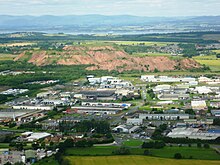Shale oil
The resulting oil can be used immediately as a fuel or upgraded to meet refinery feedstock specifications by adding hydrogen and removing impurities such as sulfur and nitrogen.[4] In the 10th century, the Arabic physician Masawaih al-Mardini (Mesue the Younger) first described a method of extracting oil from "some kind of bituminous shale".[7] The British Crown granted a patent in 1694 to three persons who had "found a way to extract and make great quantities of pitch, tarr and oyle out of a sort of stone."[7][8][9] Later sold as Betton's British Oil, the distilled product was said to have been "tried by diverse persons in Aches and Pains with much benefit.China, Estonia, New Zealand, South Africa, Spain, Sweden and Switzerland produced shale oil in the early 20th century.[11][14][15] In response to rising petroleum prices at the turn of the 21st century, extraction operations have commenced, been explored, or been renewed in the United States, China, Australia and Jordan.Thermal dissolution involves the application of solvents at elevated temperatures and pressures, increasing oil output by cracking the dissolved organic matter.A typical shale oil composition includes 0.5–1% of oxygen, 1.5–2% of nitrogen and 0.15–1% of sulfur; some deposits contain more heteroatoms than others.The US EPA has concluded that raw shale oil has a mild carcinogenic potential, comparable to some intermediate petroleum refinery products, while upgraded shale oil has lower carcinogenic potential, as most of the polycyclic aromatics are believed to have been broken down by hydrogenation.[36] Particulates in the raw oil clog downstream processes; sulfur and nitrogen create air pollution.[40] Upgrading shale oil into transport fuels requires adjusting hydrogen–carbon ratios by adding hydrogen (hydrocracking) or removing carbon (coking).
Tight oilunconventional oiloil shalepyrolysishydrogenationthermal dissolutionkerogensynthetic oil and gasupgradedrefineryfeedstockhydrogenimpuritiessulfurnitrogencrude oilInternational Energy Agencylight tight oilWorld Energy CouncilHistory of the oil shale industrymineral oilMasawaih al-MardiniSwitzerlandAustriaFrederick I, Duke of WürttembergModenashale oil extractionFranceScotlandIndustrial Revolutionwhale oilAustraliaBrazilUnited StatesEstoniaNew ZealandSouth AfricaSwedenNortheast ChinaJordanretortoil shale industriesin-situhydrogen donorssolventscrackingRoyal Dutch ShellMahogany Research ProjectGreen River FormationFushun Mining GroupVKG OilPetrobrasPetrosixextraction technologymixtureolefinicaromaticheteroatomsoxygenpourablepolycyclic aromatic hydrocarbonscarcinogenicWorld Health Organizationoil refineryParticulatesair pollutionarseniccatalystsOlefinsfree radicalsHydrodesulfurizationbenchmark crude oilPhenolshydrocrackingcokingKiviter processphenolic compoundsdiluentsbituminous materialsWorld War IIpreservativekerosenejet fueldiesel fuelAmmonium bituminosulfonateOil shale reservesBureau of Land Managementsolid fuelsUnconventional (oil & gas) reservoirOil shale economicsOil shale gasUnderground coal gasificationSpent shaleVaca MuertaCambridge University PressBrill PublishersColorado School of MinesGeological Society of LondonInstitute of Occupational MedicineMSN EncartaAmerican Association of Petroleum GeologistsUnited States Department of the InteriorUnited States Geological SurveyTallinn University of TechnologyTallinnScienceBibcodeEnergy & FuelsUnited States Department of EnergyPennWell CorporationViru Keemia GruppCRC PressMcGraw-Hill ProfessionalUnited States Environmental Protection AgencyInternational Agency for Research on CancerApplied and Environmental MicrobiologyEnergy Information Administration